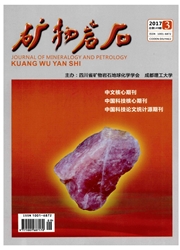

 中文摘要:
中文摘要:
在中亚造山带东段华北克拉通北缘,识别出一套晚古生代那仁乌拉黑云母花岗岩。其LA—ICP—MS锆石U—Pb年龄为267.2Ma±1.4Ma(MSWD-1.3,n-21)和捕获锆石年龄为296.3Ma~296.1Ma、278.8Ma~277.4Ma;岩石为低钾(拉斑)到高钾钙碱性,弱准铝质到过铝质I型;EREE较低,轻重稀土分馏较强(LaN/YbN:15.59~32.36)。在稀土元素配分模式图上,都表现为轻稀土富集,重稀土亏损的右倾散开式。弱到正的铕负异常(8Eu:0.79~1.08);在微量元素蛛网图上,相对富集LREE(La,Ce),,LILE(K,Rb)和HFSE(Zr,Hf),元素Nb,Ta,P,Ti,Y,Yb,Lu亏损程度较大,元素U,Th,Sr由相对亏损到富集。岩石整体具有埃迭克质岩的亲舍性,形成于弧向同碰撞过渡的构造环境;锆石£Hf(£)值(0.95~4.05)显示具有弱亏损的幔源组分特性,与主量元素、微量元素及REE一致,变化范围都较大,共同暗示其源岩的壳幔混源性。较年轻的锆石Hf模式年龄(1030.9Ma~1226.8Ma)与兴蒙造山带范围一致;那仁乌拉花岗岩与西部乌拉特中旗克布岩体,东部吉林大玉山岩体共同组成一条华北克拉通北缘埃达克质岩浆带,其都为与古亚洲洋俯冲碰撞引起的具有弧岩浆性质的年轻的基性玄武质下地壳部分熔融有关的C型埃达克岩。这条埃达克质岩浆带与稍晚期的华北克拉通北缘碱性岩浆带相对应,都具有西部形成早于东部的特征,可能暗示古亚洲洋自西向东逐渐闭合的规律。
 英文摘要:
英文摘要:
The Late Paleozoic Narenwula biotite granites occurred in the east segments of North China Craton in the Central Asia Orogenic Belt (CAOB) was considered to be formed in the Yan- shanian Period. LA-ICP-MS U-Pb age dating shows 267.2 Mail. 4 Ma age (MSWD= 1.3, n= 21) which represents the crystallized ages, and 296.3 Ma to 296.1 Ma ages and 278.8 Ma to 277.4 Ma ages which represent the xenoliths zircon ages of the biotite granites. The granite be- longs to low potassium (tholeiite) to high potassium calc-alkaline series,weak quasi-aluminous to over-aluminous rocks,and I-type granites. Its SREE values are low,and the fractionation between LREE and HREE (LaN/YbN = 15. 59--32. 36) are strong. Chondrite-normalized REE patterns show that the granite rich in LREE and depleted in HREE, with right inclined scattering models, weak to positive in negative abnormal of Eu (~Eu.0. 79 to 1.08). Compared with primitive man- tle, the trace elements relatively enrich in LREE (La and Ce),LILE (K and Rb), HFSE (Zr and Hf), and obviously depleted in elements of Nb, Ta, P, Ti, Y,Yb,and Lu. The granite possesses affinity with Adakitic rocks,and formed in the tectonic setting of island arc to syn-collision. The eHf(t) values of zircon (0.95 to 4.05) show weakly depleted mantle-derived compositions. The eHf(t) values combined with the major elements, trace elements,REE vary obviously,indicating the mixing features of crusts and mantles. The younger eHf(t) model ages of zircons (1 030.95 Ma to 1 226.84 Ma) are consistent with the ranges of XingMongolian Orogenic Belts. Therefore, an Adakitic magmas belts formed in the northern part of North China Craton, which consists of Narenwula biotite granites,Wulatezhongqi Kebu massifs in west,and Dayushan massifs in Jilin Provinces. The Adakitic granitic zones belong to the C-types Adakites resulted from partial melt- ing of the younger and basic basaltic thicken lower crust during the subduction and collision of the Paleo-Asia Ocean. The formation
 同期刊论文项目
同期刊论文项目
 同项目期刊论文
同项目期刊论文
 期刊信息
期刊信息
